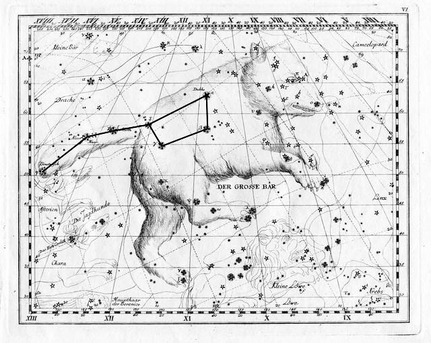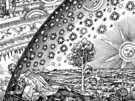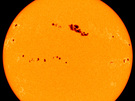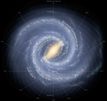"Unofficial" constellations
Where did the Little Dipper and the Big Dipper go?
The 'Little Dipper' and the 'Big Dipper' – even people without any knowledge of astronomy will at least be familiar with these names. The Little Dipper and the Big Dipper are both configurations of seven bright stars that look like a dipper (ladle or scoop). Four stars form the bowl of the dipper, the other three form the handle.
 © Johann Elert Bode
|
This illustration from Johann Elert Bode's 1782 star atlas shows the constellation of the Great Bear. The seven brightest stars of the Great Bear are also known as the Big Dipper or Plough in English.
By imagining a line between the two outermost stars of the Big Dipper – the ones furthest from the handle – and then extending it by five times, you almost immediately find the North Star (Polaris). The North Star forms the tip of the handle of the Little Dipper. In Europe, the Little Dipper and the Big Dipper are visible throughout the year and throughout the night.
Neither the Little Dipper nor the Big Dipper is on the list of official constellations.
The Little Dipper and the Big Dipper are the most well-known star configurations and they are important guideposts for the rest of the night sky. Still, strictly speaking they are not official constellations. Astronomers recognize 88 such official constellations; their names were registered in 1922 by the International Astronomical Union (IAU; the organization which in conjunction with UNESCO is organizing the International Year of Astronomy this year), putting an end to the confusion that had crept into the classification of constellations over the years.
Neither the Big Dipper nor the Little Dipper can be found in the official list of constellation names. Strictly speaking, they are just partial constellations or 'asterisms' – special groupings of stars. The Big Dipper forms part of the constellation 'Ursa Major', the Great Bear, and the Little Dipper forms part of the Little Bear or 'Ursa Minor'.
German Aerospace Center
Neither the Little Dipper nor the Big Dipper is on the list of official constellations.
The Little Dipper and the Big Dipper are the most well-known star configurations and they are important guideposts for the rest of the night sky. Still, strictly speaking they are not official constellations. Astronomers recognize 88 such official constellations; their names were registered in 1922 by the International Astronomical Union (IAU; the organization which in conjunction with UNESCO is organizing the International Year of Astronomy this year), putting an end to the confusion that had crept into the classification of constellations over the years.
Neither the Big Dipper nor the Little Dipper can be found in the official list of constellation names. Strictly speaking, they are just partial constellations or 'asterisms' – special groupings of stars. The Big Dipper forms part of the constellation 'Ursa Major', the Great Bear, and the Little Dipper forms part of the Little Bear or 'Ursa Minor'.
German Aerospace Center
"Unofficial" constellations
Where did the Little Dipper and the Big Dipper go?
The 'Little Dipper' and the 'Big Dipper' – even people without any knowledge of astronomy will at least be familiar with these names. The Little Dipper and the Big Dipper are both configurations of seven bright stars that look like a dipper (ladle or scoop). Four stars form the bowl of the dipper, the other three form the handle.
 © Johann Elert Bode
|
This illustration from Johann Elert Bode's 1782 star atlas shows the constellation of the Great Bear. The seven brightest stars of the Great Bear are also known as the Big Dipper or Plough in English.
By imagining a line between the two outermost stars of the Big Dipper – the ones furthest from the handle – and then extending it by five times, you almost immediately find the North Star (Polaris). The North Star forms the tip of the handle of the Little Dipper. In Europe, the Little Dipper and the Big Dipper are visible throughout the year and throughout the night.
Neither the Little Dipper nor the Big Dipper is on the list of official constellations.
The Little Dipper and the Big Dipper are the most well-known star configurations and they are important guideposts for the rest of the night sky. Still, strictly speaking they are not official constellations. Astronomers recognize 88 such official constellations; their names were registered in 1922 by the International Astronomical Union (IAU; the organization which in conjunction with UNESCO is organizing the International Year of Astronomy this year), putting an end to the confusion that had crept into the classification of constellations over the years.
Neither the Big Dipper nor the Little Dipper can be found in the official list of constellation names. Strictly speaking, they are just partial constellations or 'asterisms' – special groupings of stars. The Big Dipper forms part of the constellation 'Ursa Major', the Great Bear, and the Little Dipper forms part of the Little Bear or 'Ursa Minor'.
German Aerospace Center
Neither the Little Dipper nor the Big Dipper is on the list of official constellations.
The Little Dipper and the Big Dipper are the most well-known star configurations and they are important guideposts for the rest of the night sky. Still, strictly speaking they are not official constellations. Astronomers recognize 88 such official constellations; their names were registered in 1922 by the International Astronomical Union (IAU; the organization which in conjunction with UNESCO is organizing the International Year of Astronomy this year), putting an end to the confusion that had crept into the classification of constellations over the years.
Neither the Big Dipper nor the Little Dipper can be found in the official list of constellation names. Strictly speaking, they are just partial constellations or 'asterisms' – special groupings of stars. The Big Dipper forms part of the constellation 'Ursa Major', the Great Bear, and the Little Dipper forms part of the Little Bear or 'Ursa Minor'.
German Aerospace Center









